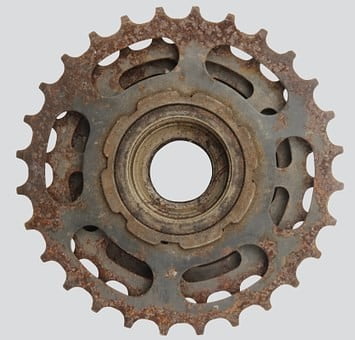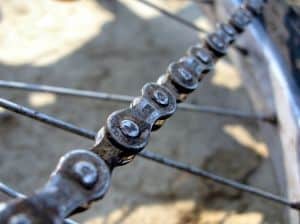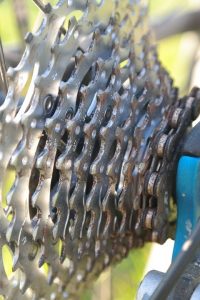Rust on a bike chain is one of the most tedious chores for any biker for a reason. It is uncommon to find rust on bikes that are constantly used due to the motion. Rust can however still accumulate on static parts such as the cog sides, gear sides as well as disc brakes. Rust is one of the most common ways that a chain will break and so needs to be well managed at any point. Most bikes will accumulate rust during storage which means that it is important that you take the time to carry out proper storage processes to ensure that your bike enjoys a longer life span. Rust can be so bad that the chain becomes completely useless needing a quick replacement.
How does rust get onto a bike chain?

Rust occurs on steel due to oxidation which needs water and oxygen. This is a typical reaction on steel, a material that chains are made of. Any exposure to these elements which is inescapable will lead to rusting on the bike chain. It is important that you know how to carry out rust removal so as to restore the integrity of your bike. Rust will also occur on some other parts of the drive train and in rare cases, the frame. This can be avoided by using powder paints on the frame. You cannot, however, do the same for the chain. Frames such as aluminum, titanium, and carbon fiber do not rust. Steel frames that are not well coated will rust badly if not well taken care of.
Beginners guide to cleaning a rusted chain
Every biker needs to learn the basics of rust removal. Rust will more often than not accumulate due to long periods of not using the bike. These are sometimes inevitable especially if you are not a keen biker. Bikers that use the bikes often will wash and lubricate them often enough to keep the rust well managed. Here is a simple guide that a beginner can use to get rid of any rust on the bike. Pros can also use the same as the results are the same.
Removing a bike chain
One of the first steps one needs to know is how to remove a bike chain. Removing a bike chain is easy especially if the bike is not a fixed pedal one. Fixed pedals may be more cumbersome but will work all the same. The trick is to offset one link, and the rest will come off quickly. Bikes with derailleurs are comfortable since you can loosen it or bring down the whole chain and later tighten it when setting the bike chain back.
Remove the residue from the drive train
Turn the bike upside down and rank it especially if the chain is stuck due to the rust. You can do this while tapping on the chain while tapping the drive train with a small metal object. Be careful not to do this hard as it will damage parts of the bike. Rust residue that is hanging loosely will fall off allowing you to fully crank the chain in preparation for proper cleaning.
What you need
Here is a list of some items required for this exercise:
- Toothbrushes and bristle brushes of various dimensions
- Dry rags
- Scouring pad
- Lime juice
- Link removal tool
- Chain lubricant
Step 1
With the bike, still upside down, you can start cleaning the whole chain using lime juice if you have not removed the chain. It is dependent on how rusty the chain is. One that is too rusty will need a good soaking in the lime juice before embarking on cleaning. The citric acid in the lime juice reacts with the rust dropping it off.
Step 2

Start scrubbing the chain after a few minutes of soaking using a scouring pad and brushes to reach the hidden parts in the chain. Rust can be a little stubborn which is why brushes with strong bristles work best to reach all the areas of the bike. Ensure that you thoroughly scrub off all the parts of the drive train to make sure that no rust is left inside the mechanism. Scrub while cranking the mechanism to allow the lime juice to seep into links and crevices.
Step 3
Finally, give your thorough bike wash with soapy water allowing the water to run freely through the drive train. This will remove the lime juice along with all the rust that has been scrubbed off. Repeat the scrubbing exercise if you find parts that have not been reached by the brushes or lime juice.
Step 4
Dry off all the water from the drive chain using dry rugs. Dry while cranking the chain to reach as many parts of it as possible. You can wipe the chain separately using the dry rags before reinstalling it onto the bike again. Ensuring that the chain is completely dry, work then to prevent further rusting even after the whole process is done. Ensure that you can see shiny steel after this entire process on every part of the drive train.
Step 5
Finally, take the time to lubricate all the movable parts of the drive train as you crank it along with the static steel parts. The best lubricant will depend on the weather and the nature of your next ride. Avoid using light lubricants such as WD40 because it wears off fast. Wet weather works with grease while dry weather works ideally with lighter oils.
Waxworks best in both conditions. Ensure that the lubricants touch every part of the chain and drive train before testing out your bike. Be sure to check for any damages on the chain before setting off.
Removing rust from bike gears

Bike gears may take a while to deal with. Lime will also work best in this situation. Pour in some lime juice and let it settle on the gears before scrubbing it off with a brush. Use a toothbrush or a brush with long, sturdy bristles. This helps reach tricky parts of the gear mechanism. Do the same for the shift cable allowing the lime to go through the sheath. Finally, wash with water and allow the rust to run off the mechanism. Dry the gears with a dry rug to get rid of all the water. Finally, lubricate the whole mechanism including the shift cable while confirming that all the lime juice and water is out of the sheath. This needs patience and careful consideration. Crank the gears as you do this to ensure that all the rust is gotten rid of. Bikes with lesser gears are easier to clean as compared to those that have more. You can also drop the bike off at a bike store to ensure that a good job is done if you doubt this will work for you. The best thing about professional cleaning and rust removal is that they will use new mechanisms that include ultrasound cleaning to get rid of all the residue. You can rest assured at this point that your bike will be 100% clean and rust-free. They not only clean but lubricate the bike with the best lubricants ensuring that your next ride is different.
Bike storage tips to avoid rust
It is important that you store your bike in a way that will minimize the accumulation of rust on the drive train. Extended periods of storage are possible but not without checking your bike often. It is important that you do not entirely forget about it. A scheduled maintenance practice is advisable for people that store bikes for a long time.
Clean the bike before storage
Dirt is one of the leading factors when it comes to rust. Dust carries a lot of moisture as well as rust including properties. Clean your bike well before any storage ensuring that all the hidden parts are reached.
Dry off the bike
Ensure that the bike is well dried after cleaning. You can use a dry rug or only set it up in the sun for a while to make sure that all the parts are dry. Let the water runoff from every part before using the dry cloth to save time. Any water on the system will attract rust.
Lubricate
Finally, oil the bike well to ensure that the dust and the water are kept off. The type of lubricant you pick will matter at this point. Grease will accumulate dust but still work well as long as you are not using the bike for a period. Dust will cause grinding action if it accumulates on the drive train. Liquid lubricants that are not too light are the best but will need to be checked on every once in a while. The wax will work for a longer period.
Note that it is wise for you to degrease your bike and lubricate it again after long periods of storage.
